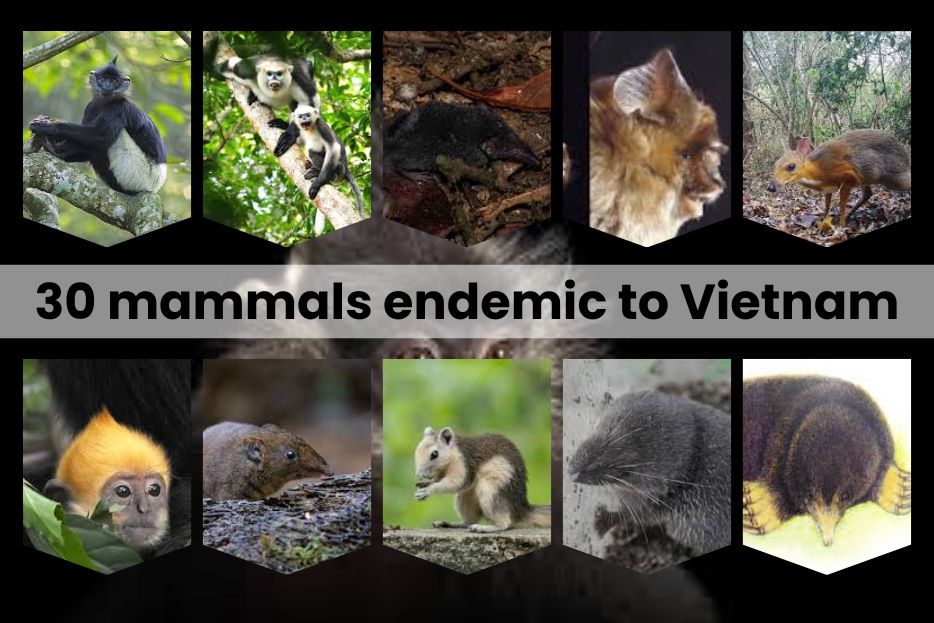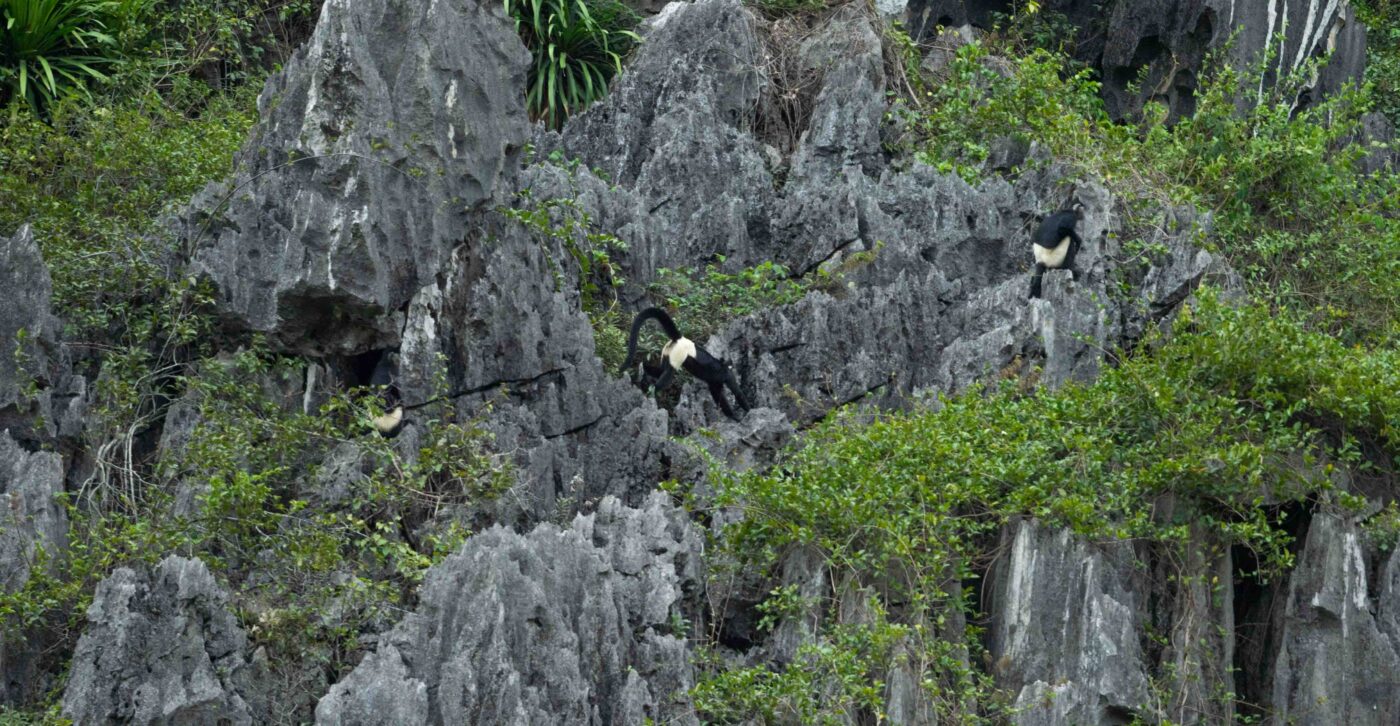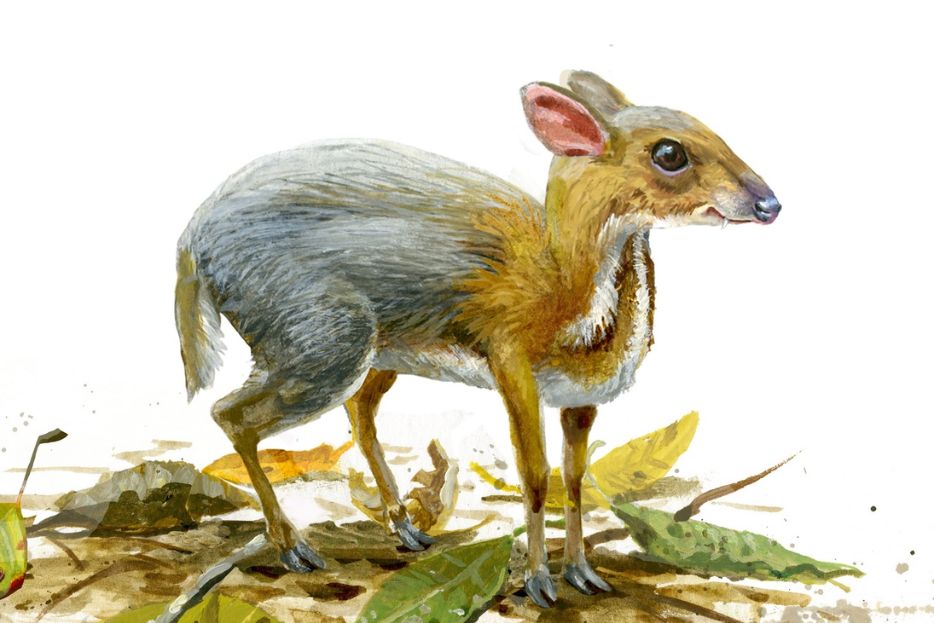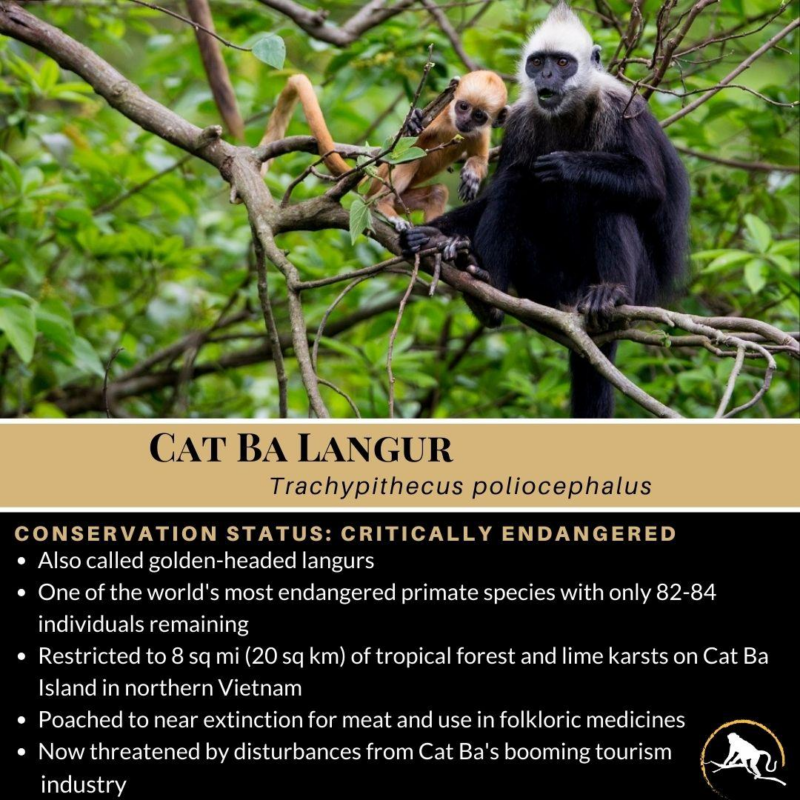Vietnam is home to an incredible variety of ecosystems and ranks 16th in the world for biodiversity. Among its rich natural heritage are 30 mammals endemic to Vietnam, species that are found nowhere else on Earth. These unique mammals are adapted to the country’s diverse landscapes, from coastal mangroves to tropical rainforests and limestone karst formations. Vietnam’s mountainous regions, including the Hoang Lien Cordillera and the Annamite Mountains, have created specialized environments where these mammals have evolved in isolation, adapting to the challenges of their habitats. However, this biodiversity is increasingly threatened by deforestation, habitat degradation, and illegal hunting, making conservation efforts more critical than ever.

Vietnam’s 30 Endemic Mammals: A Glimpse Into Diversity
Vietnam is home to an impressive array of mammals, with 30 species being entirely endemic to the country. These mammals include primates, bats, shrews, moles, and more, each playing a crucial role in their respective ecosystems.
Here is a list of the 30 mammals endemic to Vietnam:
Order: Artiodactyla
- Family: Cervidae
- Puhoat Muntjac (Muntiacus puhoatensis)
- Family: Tragulidae
- 2. Silver-backed Chevrotain (Tragulus versicolor)
Order: Chiroptera (Bats)
- Family: Hipposideridae
- 3. Dong Bac Trident Bat (Aselliscus dongbacanus)
- 4. Ha Long Leaf-nosed Bat (Hipposideros alongensis)
- 5. Griffin’s Leaf-nosed Bat (Hipposideros griffini)
- Family: Vespertilionidae
- 6. Beelzebub Tube-nosed Bat (Murina Beelzebub)
- 7. Vietnamese Tube-nosed Bat (Murina harpioloides)
- 8. Kon Tum Tube-nosed Bat (Murina kontumensis)
- 9. Phan Luong’s Myotis (Myotis phanluongi)
Order: Eulipotyphla (Shrews, Moles, and Relatives)
- Family: Soricidae (Shrews)
- 10. Annamite White-toothed Shrew (Crocidura annamitensis)
- 11. Vietnamese White-toothed Shrew (Crocidura guy)
- 12. Ke Go White-toothed Shrew (Crocidura kegoensis)
- 13. Phu Quoc White-toothed Shrew (Crocidura phuquocensis)
- 14. Sa Pa White-toothed Shrew (Crocidura sapaensis)
- 15. Sokolov White-toothed Shrew (Crocidura sokolovi)
- 16. Zaitsev’s White-toothed Shrew (Crocidura zaitsevi)
- 17. Vietnamese Water Shrew (Chimarrogale varennei)
- Family: Talpidae (Moles)
- 18. Ngoc Linh Mole (Euroscaptor ngoclinhensis)
- 19. Small-toothed Mole (Euroscaptor parvidens)
- 20. Vietnamese Mole (Euroscaptor subanura)
- 21. Fansipan Shrew Mole (Uropsilus fansipanensis)
- Family: Erinaceidae (Gymnures)
- 22. Dalat Gymnure (Hylomys macarong)
Order: Rodentia (Rodents)
- Family: Muridae
- 23. Suntsov’s Marmoset Rat (Hapalomys suntsovi)
- 24. Millet’s Long-tailed Giant Rat (Leopoldamys milleti)
- 25. Osgood’s Vietnamese Rat (Rattus osgoodi)
- 26. Daovantien’s Limestone Rat (Tonkinomys daovantieni)
- Family: Sciuridae (Squirrels)
- 27. Hon Khoai Squirrel (Callosciurus honkhoaiensis)
Order: Primates
- Family: Cercopithecidae (Old World Monkeys)
- 28. Tonkin Snub-nosed Monkey (Rhinopithecus avunculus)
- 29. Delacour’s Langur (Trachypithecus delacouri)
- 30. Cat Ba Langur (Trachypithecus poliocephalus)

Habitat and Ecosystem Specialization
Variety of Habitats
Vietnam’s landscape supports a wide variety of ecosystems that serve as critical habitats for these endemic mammals. Some species are highly specialized, such as the Fansipan Shrew Mole, which thrives in the cold, high-altitude environment of the Hoang Lien Cordillera, while others, like the Silver-backed Chevrotain, prefer the lowland forests of southern Vietnam. The Annamite Mountains serve as a vital corridor for many species, offering rugged terrain and isolated ecosystems where these mammals have evolved to thrive.
In addition to the high-altitude regions, Vietnam is home to a complex system of karst landscapes, which are essential to the survival of species like the Daovantien’s Limestone Rat. The deep caves and rugged limestone formations offer shelter and protection from human encroachment, though these areas are also under pressure from quarrying and development.

Adaptation to Unique Habitats
Many of these mammals have adapted to specialized niches within their ecosystems. For example, the Ngoc Linh Mole and the Vietnamese Mole have evolved to survive in Vietnam’s mountainous regions, tunneling through soft soils and relying on the forest floor for food. Meanwhile, species like the Griffin’s Leaf-nosed Bat and the Ha Long Leaf-nosed Bat have adapted to life in the caves and dense forests of northern Vietnam, where they play a crucial role in controlling insect populations.
Primates such as the Tonkin Snub-nosed Monkey and the Delacour’s Langur rely heavily on the dense forest canopies for shelter and sustenance. These species are highly sensitive to habitat loss and forest fragmentation, which makes protecting their habitats essential for their survival. Without the protection of large, unbroken forests, these primates are vulnerable to predation, poaching, and starvation.
Conservation Challenges
Major Threats
Despite Vietnam’s efforts to preserve its natural heritage, the endemic mammals of Vietnam face significant threats. Deforestation, driven by logging, agriculture, and infrastructure development, has severely impacted the natural habitats of many of these species. Large-scale agriculture, including the cultivation of cash crops such as coffee and rubber, has replaced vast swaths of forest, leading to habitat loss and fragmentation.
Illegal hunting and the wildlife trade are also major concerns. Many of Vietnam’s endemic species, particularly primates and small mammals, are highly sought after for their meat, fur, or as pets. The Delacour’s Langur, for instance, is critically endangered due to poaching, while the Tonkin Snub-nosed Monkey faces similar pressures. The high demand for wildlife products in both local and international markets has placed immense pressure on these already fragile populations.
Hunting Bans and Enforcement Challenges
To combat these threats, Vietnam has implemented strict hunting bans on many of its endangered species. However, enforcing these bans remains a significant challenge, particularly in remote areas where illegal hunting continues unchecked. Many conservation organizations have called for stronger enforcement measures and increased patrolling of protected areas to reduce poaching.

Habitat Protection Efforts
Vietnam has established a network of national parks and nature reserves to protect its most vulnerable ecosystems and species. Cuc Phuong National Park is one of the country’s oldest and most important protected areas, providing critical habitat for species like the Vietnamese Mole and Osgood’s Vietnamese Rat. Other parks, such as Phong Nha-Ke Bang National Park, offer refuge for bat species like the Griffin’s Leaf-nosed Bat, while the Hoang Lien National Park serves as a sanctuary for high-altitude species like the Fansipan Shrew Mole.
However, despite these efforts, habitat degradation remains a major issue. Protected areas are often underfunded, and illegal logging and encroachment are ongoing problems. Strengthening the management and oversight of these protected areas is essential for ensuring the survival of Vietnam’s endemic mammals.
Conservation Efforts and Ongoing Research
Breeding Programs and Population Recovery
For species on the brink of extinction, captive breeding programs offer a glimmer of hope. The Cat Ba Langur, one of the world’s rarest primates, has benefited
from such programs, which aim to stabilize the population and eventually reintroduce individuals into the wild. Similarly, efforts are being made to bolster populations of the Silver-backed Chevrotain and the Puhoat Muntjac through a combination of breeding programs and habitat restoration.
Community-based conservation initiatives have also proven effective in protecting endangered species. Local communities are often enlisted as stewards of their environment, working alongside conservation organizations to monitor wildlife populations and prevent poaching. These initiatives have been particularly successful in remote areas where governmental enforcement is limited.
Scientific Research and Conservation
Ongoing research plays a critical role in understanding the behavior, ecology, and population dynamics of Vietnam’s endemic mammals. Scientists are conducting field studies to map the distribution of these species and assess their population health. This research is vital for informing conservation strategies and identifying areas that require immediate protection.
In addition to field research, scientists are using genetic studies to better understand the evolutionary history of Vietnam’s endemic species. By examining the genetic diversity of these species, researchers can identify populations that are most at risk and develop targeted conservation plans to preserve their genetic integrity.
Conclusion: The Importance of Continued Conservation
The 30 mammals endemic to Vietnam are not only vital components of the country’s biodiversity but are also symbols of its rich natural heritage. Protecting these species is essential for maintaining the ecological balance of Vietnam’s unique ecosystems and ensuring that future generations can experience the country’s extraordinary wildlife.
Call to Action
To secure the future of these endemic species, it is crucial to support conservation projects and policy changes that promote the protection of natural habitats. Stronger enforcement of wildlife protection laws, coupled with community-based conservation efforts, will be key to ensuring that Vietnam’s endemic mammals are preserved for future generations.
By raising awareness and increasing support for these initiatives, both locally and globally, we can help safeguard the future of Vietnam’s remarkable wildlife.
Crocodile Trail – The Best Birding Trail in Cat Tien National Park
If you’re a birder or nature photographer planning a trip to Vietnam, few places offer [...]
Cong Troi Trail – Top 1 Dalat Plateau Birding Trail Experience
If you’re a birder or nature photographer planning a trip to Vietnam’s Central Highlands, the [...]
How to Identify the Greater Sand Plover, Tibetan Sand Plover and Siberian Sand Plover
ContentsVietnam’s 30 Endemic Mammals: A Glimpse Into DiversityHabitat and Ecosystem SpecializationAdaptation to Unique HabitatsConservation ChallengesConservation [...]
Highlights of Cat Tien National Park Reptiles and Amphibian Endemics
Spanning over 71,350 hectares of tropical forests, grasslands, and wetlands, Cat Tien National Park is [...]
Highlights of Cat Tien National Park Mammals in a World Biosphere Reserve
In addition to reptiles and birds, Cat Tien National Park is also rich in mammals, [...]
Kontum Plateau Endemic and Highlight bird
Kontum Plateau Endemic And Highlight Bird species like Chestnut-eared Laughingthrush and top birding routes while [...]